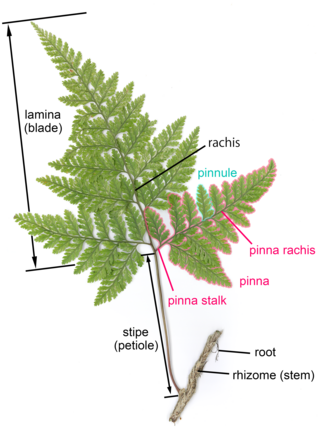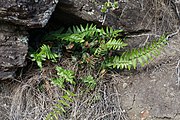
A frond is a large, divided leaf. In both common usage and botanical nomenclature, the leaves of ferns are referred to as fronds and some botanists restrict the term to this group. Other botanists allow the term frond to also apply to the large leaves of cycads, as well as palms (Arecaceae) and various other flowering plants, such as mimosa or sumac. "Frond" is commonly used to identify a large, compound leaf, but if the term is used botanically to refer to the leaves of ferns and algae it may be applied to smaller and undivided leaves.

Asplenium platyneuron, commonly known as ebony spleenwort or brownstem spleenwort, is a fern native to North America east of the Rocky Mountains. It takes its common name from its dark, reddish-brown, glossy stipe and rachis, which support a once-divided, pinnate leaf. The fertile fronds, which die off in the winter, are darker green and stand upright, while the sterile fronds are evergreen and lie flat on the ground. An auricle at the base of each pinna points towards the tip of the frond. The dimorphic fronds and alternate, rather than opposite, pinnae distinguish it from the similar black-stemmed spleenwort.
Alsophila baileyana, synonym Cyathea baileyana, also known as the wig tree fern, is a species of tree fern native to northeastern Queensland in Australia, where it grows in wet gullies and forest at an altitude of 850–1200 m. It is a rare species that is seldom found in the wild. The erect trunk is 4–5 m tall, approximately 10 cm in diameter and may be covered in stipe bases in the upper regions. C. baileyana is notable for being able to develop offshoots from the base of the trunk. Fronds are bi- or tripinnate and may be exceptionally long, up to 7 m, though they are usually around 2–3 m. The rachis and stipe are dark to darkish red, scaly and may be warty, but lack spines. Scales on the rachis and stipe are purplish brown to black and have a long hair-like apex. Characteristically of this species, the last pair of pinnae are separated from the others along the rachis and may form a clump around the trunk apex. Sori are circular and occur in one to three rows along the pinnule midvein. They lack indusia.

Asplenium trichomanes, the maidenhair spleenwort, is a small fern in the spleenwort genus Asplenium. It is a widespread and common species, occurring almost worldwide in a variety of rocky habitats. It is a variable fern with several subspecies.

Asplenium montanum, commonly known as the mountain spleenwort, is a small fern endemic to the eastern United States. It is found primarily in the Appalachian Mountains from Vermont to Alabama, with a few isolated populations in the Ozarks and in the Ohio Valley. It grows in small crevices in sandstone cliffs with highly acid soil, where it is usually the only vascular plant occupying that ecological niche. It can be recognized by its tufts of dark blue-green, highly divided leaves. The species was first described in 1810 by the botanist Carl Ludwig Willdenow. No subspecies have been described, although a discolored and highly dissected form was reported from the Shawangunk Mountains in 1974. Asplenium montanum is a diploid member of the "Appalachian Asplenium complex," a group of spleenwort species and hybrids which have formed by reticulate evolution. Members of the complex descended from A. montanum are among the few other vascular plants that can tolerate its typical habitat.

Pellaea atropurpurea, commonly known as purple-stem cliffbrake or just purple cliffbrake, is a fern native to North and Central America. Brake is an old word for fern, related to the word bracken. Like many other members of the Pteridaceae, it is a rock plant, needing a calcareous substrate.

Asplenium bradleyi, commonly known as Bradley's spleenwort or cliff spleenwort, is a rare epipetric fern of east-central North America. Named after Professor Frank Howe Bradley, who first collected it in Tennessee, it may be found infrequently throughout much of the Appalachian Mountains, the Ozarks, and the Ouachita Mountains, growing in small crevices on exposed sandstone cliffs. The species originated as a hybrid between mountain spleenwort and ebony spleenwort ; A. bradleyi originated when that sterile diploid hybrid underwent chromosome doubling to become a fertile tetraploid, a phenomenon known as allopolyploidy. Studies indicate that the present population of Bradley's spleenwort arose from several independent doublings of sterile diploid hybrids. A. bradleyi can also form sterile hybrids with several other spleenworts.

Histiopteris incisa, the bat's wing fern, water fern or fern mata, is a common plant found in Australia, New Zealand and other islands in the south Pacific region. Usually found in moist areas, where it may form large colonies. The lowermost lobes of each pinnae have a bat wing like appearance, giving the fern its common name.

Adiantum viridimontanum, commonly known as Green Mountain maidenhair fern, is a fern found only in outcrops of serpentine rock in New England and Eastern Canada. The leaf blade is cut into finger-like segments, themselves once-divided, which are borne on the outer side of a curved, dark, glossy rachis. These finger-like segments are not individual leaves, but parts of a single compound leaf. The "fingers" may be drooping or erect, depending on whether the individual fern grows in shade or sunlight. Spores are borne under false indusia at the edge of the subdivisions of the leaf, a characteristic unique to the genus Adiantum.

Asplenium tutwilerae is a rare epipetric fern found only in Hale County, Alabama, United States. A. tutwilerae is a fertile allotetraploid, formed by the chromosomal doubling of a specimen of the sterile diploid A. × ebenoides, a hybrid of A. platyneuron and A. rhizophyllum. Except for its spores, which are fertile rather than malformed, A. tutwilerae is essentially identical to A. × ebenoides and was described as part of that species until 2007. It is named in honor of Julia Tutwiler, who discovered the only known wild population at Havana Glen in 1873.
Asplenium × gravesii, commonly known as Graves' spleenwort, is a rare, sterile, hybrid fern, named for Edward Willis Graves (1882–1936). It is formed by the crossing of Bradley's spleenwort (A. bradleyi) with lobed spleenwort (A. pinnatifidum). It is only found where its parent species are both present; in practice, this proves to be a few scattered sites in the Appalachian Mountains, Shawnee Hills, and Ozarks, reaching perhaps its greatest local abundance around Natural Bridge State Resort Park. Like its parents, it prefers to grow in acid soil in the crevices of sandstone cliffs.
Asplenium × boydstoniae, commonly known as Boydston's spleenwort, is a rare, sterile, hybrid fern. It is formed by the crossing of Tutwiler's spleenwort (A. tutwilerae) with ebony spleenwort (A. platyneuron). The hybrid was produced in culture in 1954. It was not discovered in the wild until 1971, when it was found by Kerry S. Walter at Havana Glen, Alabama, the only known wild site for Tutwiler's spleenwort. Walter named it for Kathryn E. Boydston, an expert in fern culture. Except for the tip of its leaf blade, it largely resembles its ebony spleenwort parent.

Myriopteris alabamensis, the Alabama lip fern, is a moderately-sized fern of the United States and Mexico, a member of the family Pteridaceae. Unlike many members of its genus, its leaves have a few hairs on upper and lower surfaces, or lack them entirely. One of the cheilanthoid ferns, it was usually classified in the genus Cheilanthes as Cheilanthes alabamensis until 2013, when the genus Myriopteris was again recognized as separate from Cheilanthes. It typically grows in shade on limestone outcrops.
Myriopteris aemula, the Texas lip fern or rival lip fern, is a moderately-sized fern of Texas and Mexico, a member of the family Pteridaceae. Unlike many members of its genus, its leaves have a few hairs on upper and lower surfaces, or lack them entirely. One of the cheilanthoid ferns, it was usually classified in the genus Cheilanthes as Cheilanthes aemula until 2013, when the genus Myriopteris was again recognized as separate from Cheilanthes. It typically grows on limestone rock.
Myriopteris allosuroides is a moderately-sized fern of Mexico, a member of the family Pteridaceae. Unlike many members of its genus, its rachides are grooved on the upper surface and largely free of hairs or scales. One of the cheilanthoid ferns, it was usually classified in the genera Cheilanthes or Pellaea until 2013, when the genus Myriopteris was again recognized as separate from Cheilanthes. It typically grows on dry, rocky slopes over acidic, particularly basaltic, rock.

Hymenophyllum rarum, the narrow filmy-fern, is a species of fern from the family Hymenophyllaceae. This thin-leaved fern is commonly found in New Zealand and Tasmania, growing in patches on rocks and is epiphytic on trees and tree ferns, growing in moist gullies or rainforests. A rather drought tolerant species often found at exposed sites ranging from coastal to montane areas. Forming extensive, interwoven and creeping patches with its thin long (creeping) rhizomes sparsely covered in red-brown hairs, easily recognised by its membranous grey-green fronds, the smooth margins of the pinnae, ultimate segments and indusia; and by the sunken sori in the uppermost segments of the uppermost pinnae. The species can be found throughout Tasmanian rainforests as well as occurring in New South Wales, Victoria and New Zealand on the North and South Islands as well as, Stewart, Chatham and Auckland Islands.
Argyrochosma connectens is a small cheilanthoid fern endemic to Sichuan, China. It is the only member of its genus known from Asia. Relatively rare, it is found growing in the crevices of limestone rocks in hot, dry valleys. The species was long classified in the genus Pellaea, but after a phylogenetic study in 2015 was transferred to Argyrochosma.
Argyrochosma incana, the hairy false cloak fern, is a fern known from the southwestern United States through Mexico to Guatemala, and from a disjunct population in the Dominican Republic. It grows on rocky slopes and steep banks, often in forests. Like many of the false cloak ferns, it bears white powder on the underside of its leaves. First described as a species in 1825, it was transferred to the new genus Argyrochosma in 1987, recognizing their distinctness from the "cloak ferns".

Argyrochosma formosa is a fern known from eastern and central Mexico and Guatemala. It grows on rocky slopes, particularly on limestone. Unlike many members of the genus, it lacks white powder on the underside of its leaves. First described as a species in 1842, it was transferred to the new genus Argyrochosma in 1987, recognizing their distinctness from the "cloak ferns".

Sticherus tener, also known as silky fan-fern, is a common native ground-fern in the family Gleicheniaceae. It occurs growing along watercourses and drainage lines in rainforest that are dominated by Nothofagus cunninghamii. In Australia, it occurs in the states of Tasmania and Victoria. In New Zealand, it is known from two disjoint regions on the South Island. Like in other members of this genus, Sticherus tener have bright green fronds with repeatedly forking branches, branches bearing linear-shaped segments at almost right angles to the axis and form umbrella-like bush colony.














